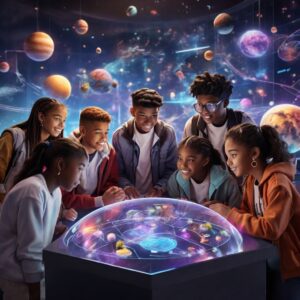
Educational games can be competitive – teams can vie to build a better tool, such as a water balloon catapult or battling robots. More often, educational games are cooperative activities. You may build something with others, or construct something virtually based on real-world physics using a computer. Learning by doing is the essence of applied science – we experiment, we guess what approaches will solve problems. When we fail, we apply lessons learned and try again. For the games and activities described here, see the Resources listed at bottom to access instructions, videos and links to more fun.
Cooperative Exploration
Some science tasks are too large for small teams to tackle. Crowdsourcing helps break down enormous tasks into smaller chunks, then presents them in a game format that anyone can grasp and play. These games help analyze cancer cells, explore the surface of the moon and ocean floors, find planets around other stars, sort the meaning of whale and bat calls, and classify animals in Africa. There’s much to explore at the Zooniverse.
Electrical Engineering
If you’re interested in building a robot warrior, you needn’t wait to form a team, join a class or enter a competition. There are numerous sources for parts and do-it-yourself guides for beginners. Servos, cameras, motors, controllers, transmitters, batteries, tools – building a robot today is like Legos on steroids. (Lego is also a player – see their Mindstorms NXT kits).
Not all robots are ground-based – some fly. While radio-controlled cars and aircraft have been around for years, it’s possible to build personal autonomous aircraft. You tell them where to go, they fly off and do it. DIY Drones has plenty of guides to get you started. Build for your own pleasure or compete with other local hobbyists to fly faster, higher and longer.
Mechanical Engineering
Building a bridge demands an understanding of materials, their strengths and limitations, the requirements of the site and loads – dead, alive and dynamic. In Bridge Builder, you can test different construction approaches and learn what works. Unlike the real world, when you fail, nobody gets hurt.
Water balloon battles are a summer favorite. You can take it to the next level by building a large slingshot, catapult or trebuchet. Now you can learn the physics of parabolas with real-world target practice. Aim well, or you may soon be all wet! Make magazine has detailed step by step instructions.
Geography
Google Earth is a lot of fun all by itself – you’ve got a whole planet to play with (more, actually – the Moon and Mars is included). At Planet In Action, there’s a collection of games that work together with Google Earth. If you’re looking for multiplayer action, look at Google Earth War, where the entire planet becomes your battlefield.
Want to do a bit of near-space photography? It’s not especially difficult or expensive. Dedicated teams have lofted small weather balloons equipped with cameras 20 miles up to capture astonishing views of earth’s curvature and black skies. Tutorials abound. Create rival teams to see who can fly higher or gather the most interesting photos and videos!
Astronomy
As long as you’re looking up, try running the Messier Marathon. Every spring, conditions are favorable for surveys of 100 deep sky objects. These galaxies, star clusters and nebulae were first discovered and cataloged by Charles Messier, an 18th century French astronomer. Your challenge is to view them all in one evening. You’ll need a good telescope, clear skies and patience. You’ll learn a lot along the way.
Aerospace
Here is a trio of games all built to reflect real-world physics. Two of them emulate real-world vehicles. X-Plane is a sophisticated flight simulator that offers an amazing range of aircraft that you can fly over real-world terrain in real-world weather conditions, with authentic failure scenarios. In Orbiter, you can pilot an Apollo command module to the moon, dock with the International Space Station from a Space Shuttle or Soyuz, then re-enter and land. In the Kerbal Space Program, you build your own spacecraft subject to real-world limitations of materials, weight and fuel. You can build your own moon base, ferry supplies and discover what happens when you run short.